Huge Subterranean Pre-Columbian Shaft Tombs In Tierradentro, Colombia
A. Sutherland - AncientPages.com - One of the most representative historical and archaeological places of Colombia is Tierradentro, known as the National Archaeological Park located in the municipality of Inzá, Department of Cauca, Colombia.
Entrance to the underground tomb with spiral staircase. Image credit: inyucho - CC BY 2.0
The area of Tierradentro holds the largest concentration of pre-Columbian monumental shaft tombs with side chambers - known as hypogea ("under the earth"), carved in the volcanic tuff below hilltops and mountain ridges.
These ancient hypogea are large and elaborate subterranean funerary chambers, very similar to those that existed in ancient Egypt.
The most elaborate structures along with stone sculptures of various deities, some measuring up to 12 m wide and 7 m deep, were made from 600 to 900 AD. The hypogea were opened by their builders in the rock, like wells through which one descends by complicated spiral staircases.
The typical hypogeum with oval plan chambers, the convex roof supported by two or three large columns and, additionally with three, five, or seven niches around.
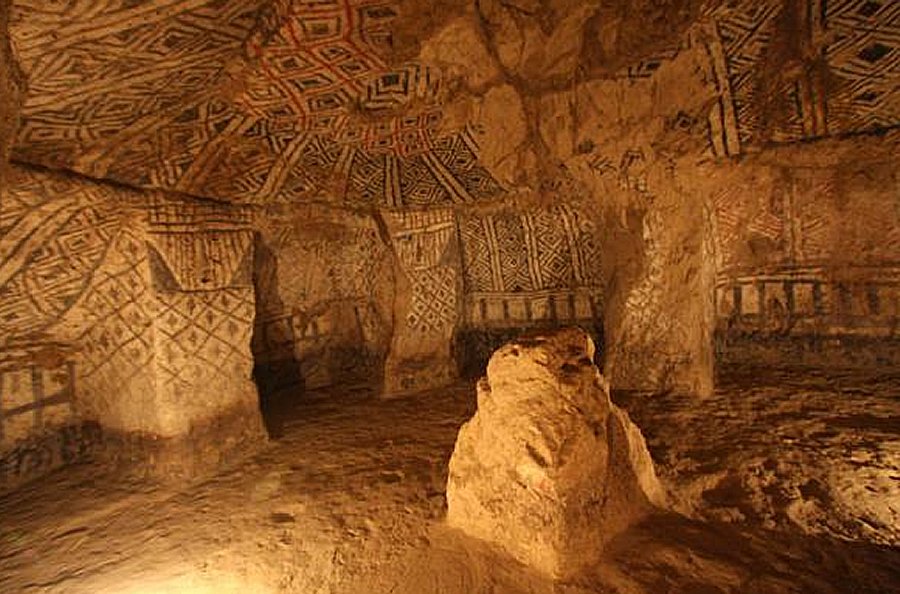 The smaller hypogea vary from 2.5 m to 7 m in depth, with oval floors 2.5-3 m wide, while the chambers of the largest examples may be 10-12 m wide. image source
The smaller hypogea vary from 2.5 m to 7 m in depth, with oval floors 2.5-3 m wide, while the chambers of the largest examples may be 10-12 m wide. image source
The hypogeum has an entry oriented towards the west, a spiral staircase, and the main chamber (wide and deep), usually 5 to 8 meters below the surface, with doors of varied shapes, an access staircase, and with several lesser chambers around, each one containing a corpse.
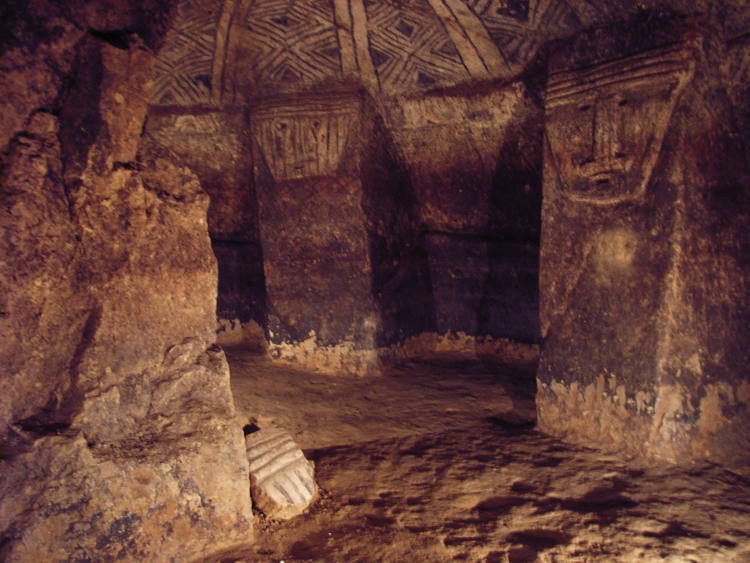 The stone statues of the Tierradentro region are of great importance. They are carved from the stone of volcanic origin and represent standing human figures, with their upper limbs placed on their chests. image source
The stone statues of the Tierradentro region are of great importance. They are carved from the stone of volcanic origin and represent standing human figures, with their upper limbs placed on their chests. image source
The interior of Tierradentro has beautiful paintings in red, white, and black mineral pigments that cover walls, columns, and vaulted ceilings. These surfaces are covered with geometric, anthropomorphic, and zoomorphic. Decorations include carved figures of mysterious beings, carved on the pilasters (rectangular columns projecting from a wall) that separate the niches.
The pre-Columbian culture that created this funeral complex inhabited this area during the first millennium AD.
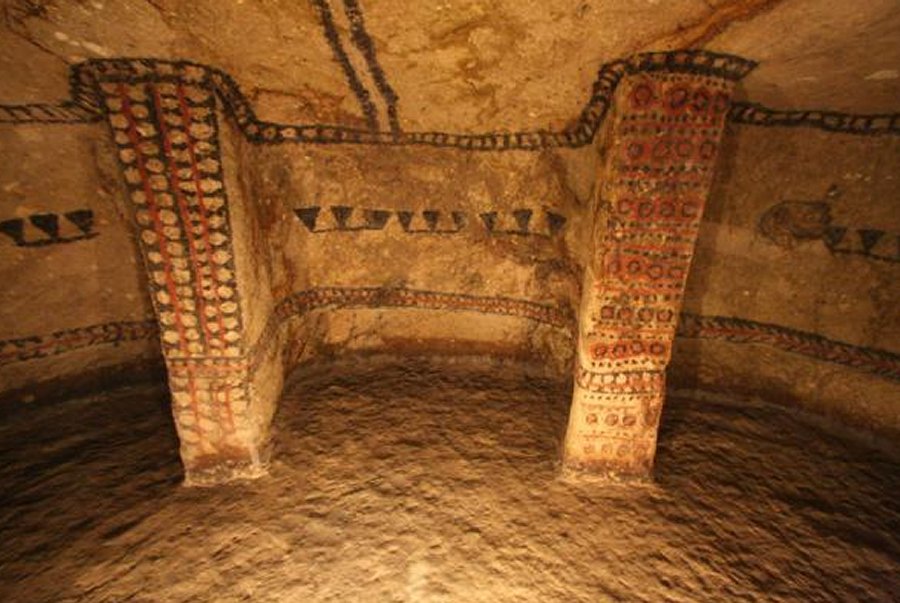 Tierradentro - an underground burial chamber hacked out in the volcanic rock, with colorful geometrical figures painted on the walls and the columns. image source
Tierradentro - an underground burial chamber hacked out in the volcanic rock, with colorful geometrical figures painted on the walls and the columns. image source
As we know, there are underground tombs with side chambers that have been found over the whole of America, from Mexico to north-western Argentina, but their largest concentration is in Colombia.
Tierradentro, however, is not only about the concentration of the tombs, but first of all their features like a vertical shaft, spiral stairs, entrance hall, and side chamber with central and surrounding columns on a large oval floor-plan, along with anthropomorphic representations and polychrome paintings – make this Colombian funerary place so unique.
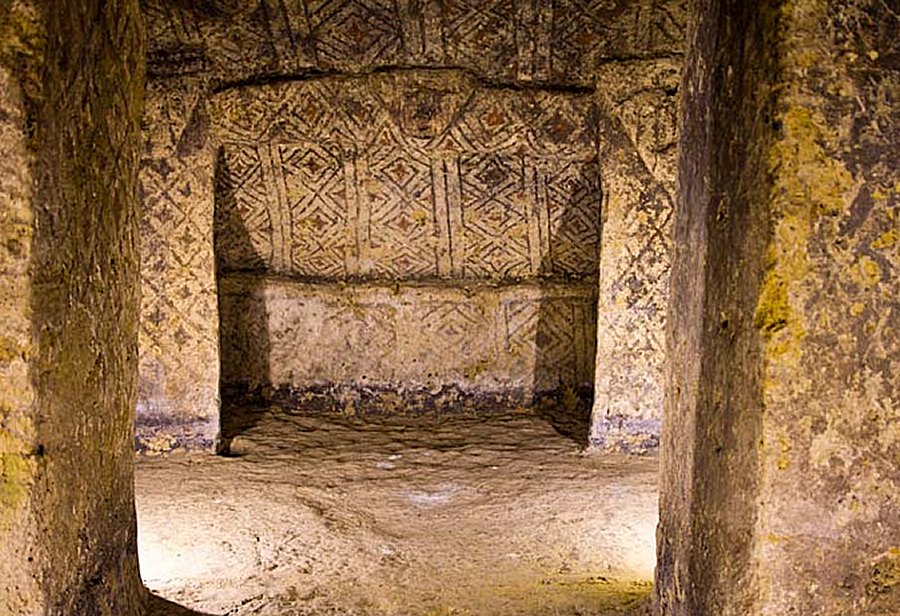 The main attributes of Tierradentro hypogea are the architectural features of the tombs, including the stairs and chambers, and the internal decoration including carvings and mural paintings. source
The main attributes of Tierradentro hypogea are the architectural features of the tombs, including the stairs and chambers, and the internal decoration including carvings and mural paintings. source
The uniqueness of the site lies in its large size and the staircases which in some cases give access to a hall.
The smaller hypogea vary from 2.5 m to 7 m in depth, with oval floors 2.5 to 3 m wide, while the chambers of the largest examples may be 10 to 12 m wide.
For now, it has not yet been possible to clarify whether the craftsmen who carved the statues lived in the same town as those who produced the Tierradentro hypogeum.
Written by – A. Sutherland - AncientPages.com Senior Staff Writer
Copyright © AncientPages.com All rights reserved. This material may not be published, broadcast, rewritten or redistributed in whole or part without the express written permission of AncientPages.com
Expand for referencesMore From Ancient Pages
-
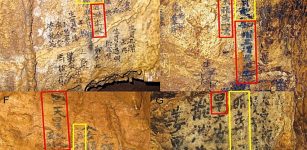 ‘Graffiti’ Found On The Walls Of Dayu Cave, China
News | Aug 25, 2015
‘Graffiti’ Found On The Walls Of Dayu Cave, China
News | Aug 25, 2015 -
 Nimerigar: Mythological Race Of Little People Living In Wyoming
Featured Stories | Jun 7, 2017
Nimerigar: Mythological Race Of Little People Living In Wyoming
Featured Stories | Jun 7, 2017 -
 Fossilized Remains Of A Gigantic Jurassic Pterosaur Unearthed In Oxfordshire, UK
Fossils | Jun 5, 2024
Fossilized Remains Of A Gigantic Jurassic Pterosaur Unearthed In Oxfordshire, UK
Fossils | Jun 5, 2024 -
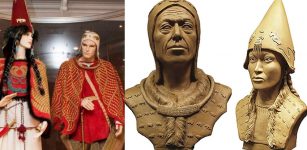 Stunning Facial Reconstruction Of ‘Siberian Tutankhamun’ And His ‘Queen’ Who Died 2,600 Years Ago
Archaeology | Jan 12, 2021
Stunning Facial Reconstruction Of ‘Siberian Tutankhamun’ And His ‘Queen’ Who Died 2,600 Years Ago
Archaeology | Jan 12, 2021 -
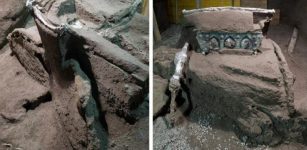 Extraordinary Ancient Roman Ceremonial Chariot Discovered In Pompeii – It’s Still Almost Intact
Archaeology | Mar 1, 2021
Extraordinary Ancient Roman Ceremonial Chariot Discovered In Pompeii – It’s Still Almost Intact
Archaeology | Mar 1, 2021 -
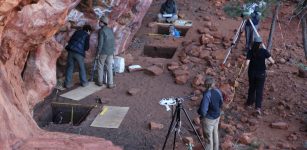 Ancient Campfires Reveal A 50,000-Year-Old Grocer And Pharmacy In Australia
Archaeology | Apr 14, 2022
Ancient Campfires Reveal A 50,000-Year-Old Grocer And Pharmacy In Australia
Archaeology | Apr 14, 2022 -
 Did The Biblical Magi Bring Jesus Gifts With Healing Properties?
Biblical Mysteries | Dec 24, 2017
Did The Biblical Magi Bring Jesus Gifts With Healing Properties?
Biblical Mysteries | Dec 24, 2017 -
 Mystery Of Vangchhia Ancient Site: Water Pavilion And Ingenious Idea Of Water Harvesting
Archaeology | Feb 21, 2019
Mystery Of Vangchhia Ancient Site: Water Pavilion And Ingenious Idea Of Water Harvesting
Archaeology | Feb 21, 2019 -
 America’s Oldest Tombstone: Jamestown’s Black “Marble” Knight’s Tombstone Was Imported From Belgium
Archaeology | Sep 27, 2024
America’s Oldest Tombstone: Jamestown’s Black “Marble” Knight’s Tombstone Was Imported From Belgium
Archaeology | Sep 27, 2024 -
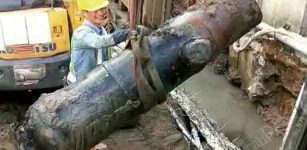 Old Cannon Found At Construction Site
Archaeology | Apr 22, 2020
Old Cannon Found At Construction Site
Archaeology | Apr 22, 2020 -
 2000-Years Old Road Was Discovered In Manisa Province,Turkey
Archaeology | Aug 14, 2017
2000-Years Old Road Was Discovered In Manisa Province,Turkey
Archaeology | Aug 14, 2017 -
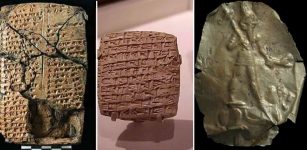 Kültepe: Once Part Of The Kingdom Of Hittites And The Center of a complex network of Assyrian trade colonies in the 2nd millennium B.C.
Civilizations | Oct 16, 2015
Kültepe: Once Part Of The Kingdom Of Hittites And The Center of a complex network of Assyrian trade colonies in the 2nd millennium B.C.
Civilizations | Oct 16, 2015 -
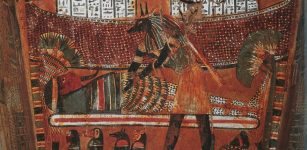 Immortal God Anubis: Lord Of The Sacred Land, Jackal God Of Mummification
Egyptian Mythology | Sep 19, 2016
Immortal God Anubis: Lord Of The Sacred Land, Jackal God Of Mummification
Egyptian Mythology | Sep 19, 2016 -
 Rare Bronze Hand Found At Roman Vindolanda
Archaeology | Jul 11, 2023
Rare Bronze Hand Found At Roman Vindolanda
Archaeology | Jul 11, 2023 -
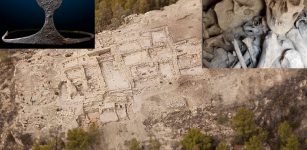 El Argar Civilization: Bronze Age Palace And Grave Goods Unearthed In Spain’s La Almoloya
Archaeology | Oct 15, 2014
El Argar Civilization: Bronze Age Palace And Grave Goods Unearthed In Spain’s La Almoloya
Archaeology | Oct 15, 2014 -
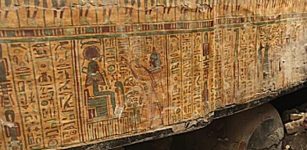 At Least 20 Ancient Colored Wooden Coffins Discovered In Asasif Necropolis, Luxor
Archaeology | Oct 15, 2019
At Least 20 Ancient Colored Wooden Coffins Discovered In Asasif Necropolis, Luxor
Archaeology | Oct 15, 2019 -
 On This Day In History: Johannes Kepler ‘Father Of Modern Astronomy’ Was Born – On Dec 27, 1571
News | Dec 27, 2016
On This Day In History: Johannes Kepler ‘Father Of Modern Astronomy’ Was Born – On Dec 27, 1571
News | Dec 27, 2016 -
 Mystery Of Biblical Adam – A Hidden Story Within A Story Open To Interpretation
Ancient Mysteries | Jan 18, 2018
Mystery Of Biblical Adam – A Hidden Story Within A Story Open To Interpretation
Ancient Mysteries | Jan 18, 2018 -
 Being Anglo-Saxon Was A Matter Of Language And Culture, Not Genetics
Archaeology | Jun 23, 2021
Being Anglo-Saxon Was A Matter Of Language And Culture, Not Genetics
Archaeology | Jun 23, 2021 -
 Is Biblical Mount Sinai Located In Har Karkom Where Mesopotamian Moon God Sin Was Worshipped?
Biblical Mysteries | Mar 20, 2017
Is Biblical Mount Sinai Located In Har Karkom Where Mesopotamian Moon God Sin Was Worshipped?
Biblical Mysteries | Mar 20, 2017

